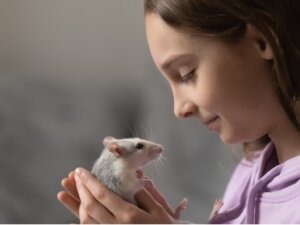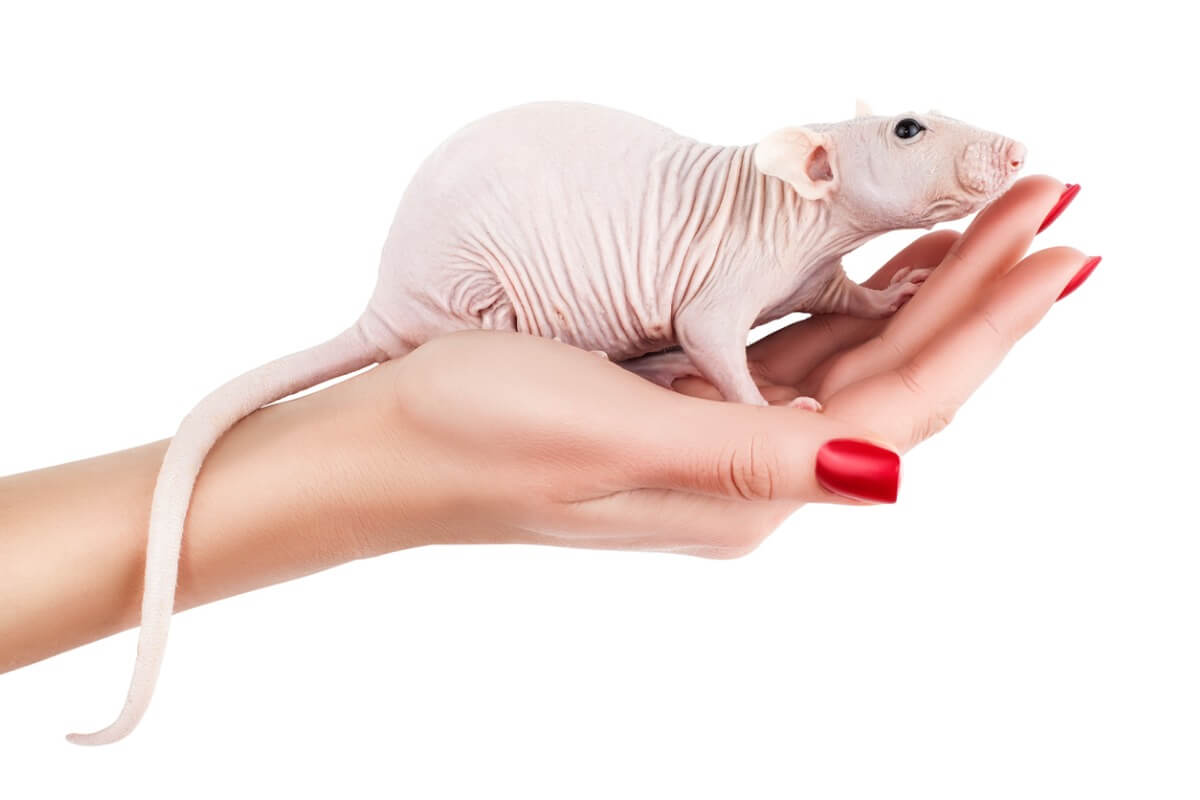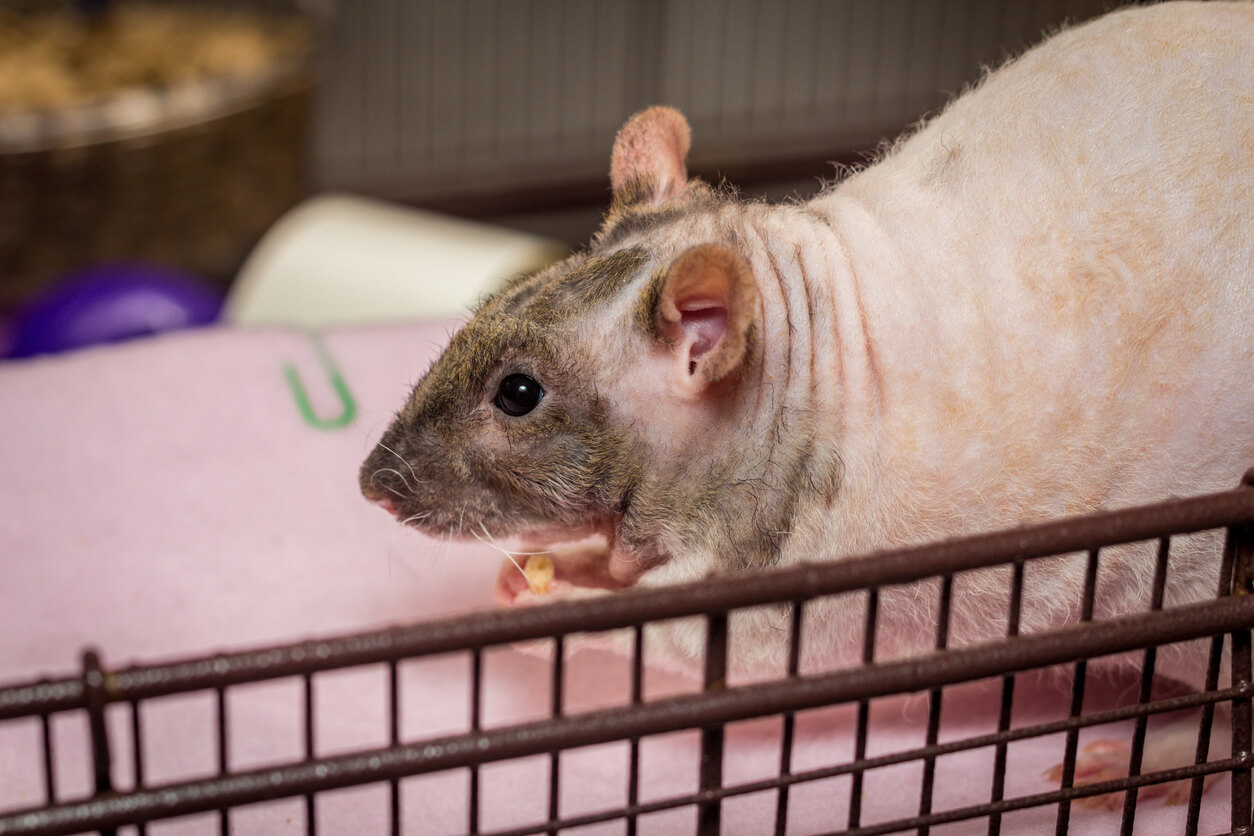9 Types of House Rats


Reviewed and approved by the biologist Samuel Sanchez
Rats are intelligent and very sociable animals. They’re normally active at night, at dusk, and at dawn. They have an excellent sense of touch and a wonderful sense of smell. There are several types of house rats that vary mainly in their color or coat.
House rats are rewarding to care for and form close bonds with their humans as long as their needs are met. They usually live for about 2 years, but some can last a little longer. Having them as a companion animal requires great responsibility and commitment, but it’s always worth it.
Types of house rats
Basically, rats can be found wherever there are people. In the wild, these rodents dig burrows to live, and, because they’re good swimmers, they can often be found living in sewers.
Rats exist in many color patterns, from dark brown to silver. They’re very popular as pets and even have breed standards like cats and dogs. Some don’t have hair, others don’t have a tail, and others have curly fur. Learn about 9 of them here.
1. Manx rat
These rats are distinguished by their lack of a tail, a mutation that causes this alteration in the structure of their body, specialists say. They can vary in color and they can sometimes have other physical abnormalities due to not having a tail, such as difficulty walking, impediments when climbing, or skeletal problems. However, this can be prevented by breeding only healthy Manx rats.
Genetic selection can prevent the accumulation of abnormalities in this breed.
2. Rex rat
This type of house rat is characterized by its curly coat, which can be in any color, however, the density of its curls can vary. Their whiskers are also wavy and, normally, males have more brittle fur than the females.
This breed was bred by the geneticist Roy Robinson in 1976 in England, the year in which it was also standardized by the National Fancy Rat organization. Their fur tends to thin out over time and doesn’t re-curl, so this trait isn’t permanent.
3. Common rat
This breed looks a lot like a wild rat. Its tail is roughly equal to the length of its body and it has a standard diet with no unusual or exceptional requirements. With regular and careful handling, these rodents can become very affectionate companions. Within this type of domestic rats, two breeds can be highlighted:
- Rattus norvegicus domestica, which was derived from the selective crossing of rattus norvegicus, the brown rat. It’s the most common subspecies kept as a pet.
- Rattus rattus, the black rat, also known as “ship rat”, “roof rat”, or “common rat”. It’s sometimes kept as a pet, however, most companion rats are domesticated from rattus norvegicus.

4. Hairless rat
There are several domestic hairless rats. Some of them don’t have fur on their bodies, but they do have a bit of short curly hair on their feet and on their noses, next to their wavy whiskers. Others have very short fur and their whiskers are small and curly.
Other rats are bald and without whiskers, also known as sphynx, which are selectively bred so that they don’t have any hair. They can get sick easily and should be given extra warmth.

5. Dumbo rat
The common rat has its ears on the top of its head and the dumbo rat has them lower, on the side of its head. As its name implies, its ears are much larger, and even its entire head appears to be larger. Their fur can vary in color, and their friendliness can vary too – this is determined by the level of interaction with their owners.
https://www.youtube.com/watch?v=ju1RejdiaWM
6. Satin rat
This satin-coated house rat receives its name due to its long, shiny coat. When it’s young, it’s difficult to distinguish it from other breeds, and the best way is by looking at its whiskers, which are curled at the tip.
7. Dwarf rat
These rodents aren’t just small versions of standard rats, as they show certain behavioral changes compared to other specimens on this list. They’re easily scared and don’t have much confidence. Because of this, they need the company of a calm person. After about a year, they relax if you look after them well.
As their name implies, the tails and legs of these rats are shorter in proportion to their bodies, their eyes are larger compared to their heads, and females can’t reproduce before 6 months of age. In short, they’re rodents in a mini format.
8. Angora rats
The Angora rat is the newest rat mutation at the moment, so not much is known about them. It’s a long, soft-haired rodent with tight curls and shiny fur like a satin mouse.
9. Patchwork rat
There aren’t many of these house rats, so they’re considered rare and represent one of the less common varieties. These rodents constantly shed their hair in unique patterns. There’s no other rat like them.

More varieties of house rats
There are other variants that refer to the coloration of each rat. They aren’t widely recognized, but they are so different that they can be considered as separate breeds. Some of these are as follows:
- Topaz
- Lilac Agouti
- Cinnamon Pearl
- Silver Fawn
- Powder Blue
In addition to the more well-known types of house rats, the National Fancy Rat Society recognizes at least 21 new varieties. They all make excellent pets, and they’re gaining more and more popularity.
Curiosities about house rats
The Ambassador and Animal Resources Information Center (AARIC) says that the average weight of a domestic rat is about 3/4 of a pound. From head to tail, these rodents are 14 to 18 inches long, and the males are generally larger than the females.
Did you know that rats regulate their temperature through their tails? There are many more curiosities about these animals that you can discover. Take a look at the following:
- Rats aren’t in danger of extinction. In fact, in many areas they outnumber humans.
- House rats are prey to almost any predator that’s larger than they are. However, when they’re raised with other pets such as cats and dogs, they develop bonds without problems. The specimens in the wild aren’t so lucky.
- It’s important to treat rat bites seriously, as many harbor bacteria that cause a disease called rat bite fever.
- A pregnant female won’t build a nest until the day before or the time she gives birth. After a gestation period of 21 to 23 days, she’ll give birth to anything up to 22 young. Although she only has 12 nipples, a female can care for a larger litter as long as she receives proper nutrition. She’ll simply divide her young into two groups and thus alternate feeding.
- Instead of purring like a cat, a happy rat chatters or gnashes its teeth. Chattering teeth often cause the eyes to “vibrate” because the lower jaw presses on the back of the eye apparatus.

As you can see, apart from being good company, rats are full of surprises, as well as having aspects to their care that you should take into account. There are many breeds, and all should receive care and attention, although some more than others. Taking care of its food, its comfort, and giving it a good environmental enrichment will surely make your rat a very happy being.
Rats are intelligent and very sociable animals. They’re normally active at night, at dusk, and at dawn. They have an excellent sense of touch and a wonderful sense of smell. There are several types of house rats that vary mainly in their color or coat.
House rats are rewarding to care for and form close bonds with their humans as long as their needs are met. They usually live for about 2 years, but some can last a little longer. Having them as a companion animal requires great responsibility and commitment, but it’s always worth it.
Types of house rats
Basically, rats can be found wherever there are people. In the wild, these rodents dig burrows to live, and, because they’re good swimmers, they can often be found living in sewers.
Rats exist in many color patterns, from dark brown to silver. They’re very popular as pets and even have breed standards like cats and dogs. Some don’t have hair, others don’t have a tail, and others have curly fur. Learn about 9 of them here.
1. Manx rat
These rats are distinguished by their lack of a tail, a mutation that causes this alteration in the structure of their body, specialists say. They can vary in color and they can sometimes have other physical abnormalities due to not having a tail, such as difficulty walking, impediments when climbing, or skeletal problems. However, this can be prevented by breeding only healthy Manx rats.
Genetic selection can prevent the accumulation of abnormalities in this breed.
2. Rex rat
This type of house rat is characterized by its curly coat, which can be in any color, however, the density of its curls can vary. Their whiskers are also wavy and, normally, males have more brittle fur than the females.
This breed was bred by the geneticist Roy Robinson in 1976 in England, the year in which it was also standardized by the National Fancy Rat organization. Their fur tends to thin out over time and doesn’t re-curl, so this trait isn’t permanent.
3. Common rat
This breed looks a lot like a wild rat. Its tail is roughly equal to the length of its body and it has a standard diet with no unusual or exceptional requirements. With regular and careful handling, these rodents can become very affectionate companions. Within this type of domestic rats, two breeds can be highlighted:
- Rattus norvegicus domestica, which was derived from the selective crossing of rattus norvegicus, the brown rat. It’s the most common subspecies kept as a pet.
- Rattus rattus, the black rat, also known as “ship rat”, “roof rat”, or “common rat”. It’s sometimes kept as a pet, however, most companion rats are domesticated from rattus norvegicus.

4. Hairless rat
There are several domestic hairless rats. Some of them don’t have fur on their bodies, but they do have a bit of short curly hair on their feet and on their noses, next to their wavy whiskers. Others have very short fur and their whiskers are small and curly.
Other rats are bald and without whiskers, also known as sphynx, which are selectively bred so that they don’t have any hair. They can get sick easily and should be given extra warmth.

5. Dumbo rat
The common rat has its ears on the top of its head and the dumbo rat has them lower, on the side of its head. As its name implies, its ears are much larger, and even its entire head appears to be larger. Their fur can vary in color, and their friendliness can vary too – this is determined by the level of interaction with their owners.
https://www.youtube.com/watch?v=ju1RejdiaWM
6. Satin rat
This satin-coated house rat receives its name due to its long, shiny coat. When it’s young, it’s difficult to distinguish it from other breeds, and the best way is by looking at its whiskers, which are curled at the tip.
7. Dwarf rat
These rodents aren’t just small versions of standard rats, as they show certain behavioral changes compared to other specimens on this list. They’re easily scared and don’t have much confidence. Because of this, they need the company of a calm person. After about a year, they relax if you look after them well.
As their name implies, the tails and legs of these rats are shorter in proportion to their bodies, their eyes are larger compared to their heads, and females can’t reproduce before 6 months of age. In short, they’re rodents in a mini format.
8. Angora rats
The Angora rat is the newest rat mutation at the moment, so not much is known about them. It’s a long, soft-haired rodent with tight curls and shiny fur like a satin mouse.
9. Patchwork rat
There aren’t many of these house rats, so they’re considered rare and represent one of the less common varieties. These rodents constantly shed their hair in unique patterns. There’s no other rat like them.

More varieties of house rats
There are other variants that refer to the coloration of each rat. They aren’t widely recognized, but they are so different that they can be considered as separate breeds. Some of these are as follows:
- Topaz
- Lilac Agouti
- Cinnamon Pearl
- Silver Fawn
- Powder Blue
In addition to the more well-known types of house rats, the National Fancy Rat Society recognizes at least 21 new varieties. They all make excellent pets, and they’re gaining more and more popularity.
Curiosities about house rats
The Ambassador and Animal Resources Information Center (AARIC) says that the average weight of a domestic rat is about 3/4 of a pound. From head to tail, these rodents are 14 to 18 inches long, and the males are generally larger than the females.
Did you know that rats regulate their temperature through their tails? There are many more curiosities about these animals that you can discover. Take a look at the following:
- Rats aren’t in danger of extinction. In fact, in many areas they outnumber humans.
- House rats are prey to almost any predator that’s larger than they are. However, when they’re raised with other pets such as cats and dogs, they develop bonds without problems. The specimens in the wild aren’t so lucky.
- It’s important to treat rat bites seriously, as many harbor bacteria that cause a disease called rat bite fever.
- A pregnant female won’t build a nest until the day before or the time she gives birth. After a gestation period of 21 to 23 days, she’ll give birth to anything up to 22 young. Although she only has 12 nipples, a female can care for a larger litter as long as she receives proper nutrition. She’ll simply divide her young into two groups and thus alternate feeding.
- Instead of purring like a cat, a happy rat chatters or gnashes its teeth. Chattering teeth often cause the eyes to “vibrate” because the lower jaw presses on the back of the eye apparatus.

As you can see, apart from being good company, rats are full of surprises, as well as having aspects to their care that you should take into account. There are many breeds, and all should receive care and attention, although some more than others. Taking care of its food, its comfort, and giving it a good environmental enrichment will surely make your rat a very happy being.
All cited sources were thoroughly reviewed by our team to ensure their quality, reliability, currency, and validity. The bibliography of this article was considered reliable and of academic or scientific accuracy.
Camarattery. (s. f.). Manx. Camarattery – Colorado Rat Breeder. Recuperado 20 de agosto de 2021, de https://camarattery.com/manx.htm
Cosgrove, N. (2021, 17 junio). 16 Types of Pet Rats: Breeds, Colors & Patterns (with Pictures). Pet Keen. https://petkeen.com/rats-breed-type-colors-patterns/
Kokeefe, M. (2018, 13 septiembre). Domestic Rat. Ambassador Animal. https://aaric.org/2018/09/13/domestic-rat/
Meggitt, J. (2020, 19 noviembre). Colors & Breeds of Ferrets. Pets on Mom.Com. https://animals.mom.com/colors-breeds-ferrets-4351.html
Roedor, P. (2018, 29 agosto). Rata Rex. Planeta Roedor. https://planetaroedor.com/ratas/rex/
RSPCA. (s. f.). Guidance on caring for your rat & rodents | RSPCA. Recuperado 20 de agosto de 2021, de https://www.rspca.org.uk/adviceandwelfare/pets/rodents/rats
Wikipedia contributors. (2021, 20 agosto). Fancy rat. Wikipedia. https://en.wikipedia.org/wiki/Fancy_rat
This text is provided for informational purposes only and does not replace consultation with a professional. If in doubt, consult your specialist.








